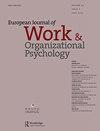年龄刻板印象的时间动态和工作中的繁荣
IF 3.4
2区 心理学
Q2 MANAGEMENT
European Journal of Work and Organizational Psychology
Pub Date : 2022-11-23
DOI:10.1080/1359432X.2022.2149396
引用次数: 0
摘要
摘要尽管人们对工作中的成功因素进行了广泛的研究,但很少关注可能阻碍成功的因素。这项日常日记研究建立在基于年龄的元刻板印象激活模型的基础上,以填补这一研究空白。根据这个模型,员工可能会挑战基于年龄的负面元刻板印象(NABM),或感到受到威胁。因此,本研究考察了基于年龄的刻板印象威胁(ABST)在繁荣体验中的作用——学习和活力的结合感——并分析了感知到的年龄相似性是否会调节对NABM的威胁反应。数据是在连续五个工作日内从82名白领员工中收集的,其中大多数在服务业工作。研究结果表明,NABM具有第二天的后果。具体而言,NABM直接阻碍了第二天的活力水平,并间接地通过ABST整体员工的成长和学习,突出了成长维度的独特性。此外,适度分析显示了感知年龄相似性的“数字安全效应”。由于现有的描述未能具体说明NABM在工作场所的影响的时间周期,本研究通过推进NABM对繁荣的第二天影响,为年龄歧视文献做出了贡献。本文章由计算机程序翻译,如有差异,请以英文原文为准。
The temporal dynamics of age metastereotyping and thriving at work
ABSTRACT While extensive research has been carried out on thriving at work enablers, scarce attention has been devoted to the factors that may obstruct thriving. This daily diary study builds on the age-based metastereotype activation model to fill this research gap. According to this model, employees may challenge negative age-based metastereotypes (NABM) or feel threatened by them. Thus, this study examines the role of age-based stereotype threat (ABST) in the thriving experience – a combined sense of learning and vitality – and analyzes whether perceived age similarity moderates the threat reaction to NABM. Data were collected over the course of five consecutive workdays from 82 white-collar employees, most of whom were working in the services sector. The findings indicate that NABM have next-day consequences. Specifically, NABM directly obstruct next-day vitality levels and indirectly overall employee thriving and learning through ABST, highlighting thriving dimensions’ distinctiveness. Additionally, moderation analyses showed a “safety‑in‑numbers-effect” of perceived age similarity. As existing accounts fail to specify the time cycle of NABM consequences in the workplace, this study contributes to the ageism literature by advancing next-day effects of NABM on thriving.
求助全文
通过发布文献求助,成功后即可免费获取论文全文。
去求助
来源期刊
CiteScore
8.00
自引率
2.30%
发文量
40
期刊介绍:
The mission of the European Journal of Work and Organizational Psychology is to promote and support the development of Work and Organizational Psychology by publishing high-quality scientific articles that improve our understanding of phenomena occurring in work and organizational settings. The journal publishes empirical, theoretical, methodological, and review articles that are relevant to real-world situations. The journal has a world-wide authorship, readership and editorial board. Submissions from all around the world are invited.

 求助内容:
求助内容: 应助结果提醒方式:
应助结果提醒方式:


